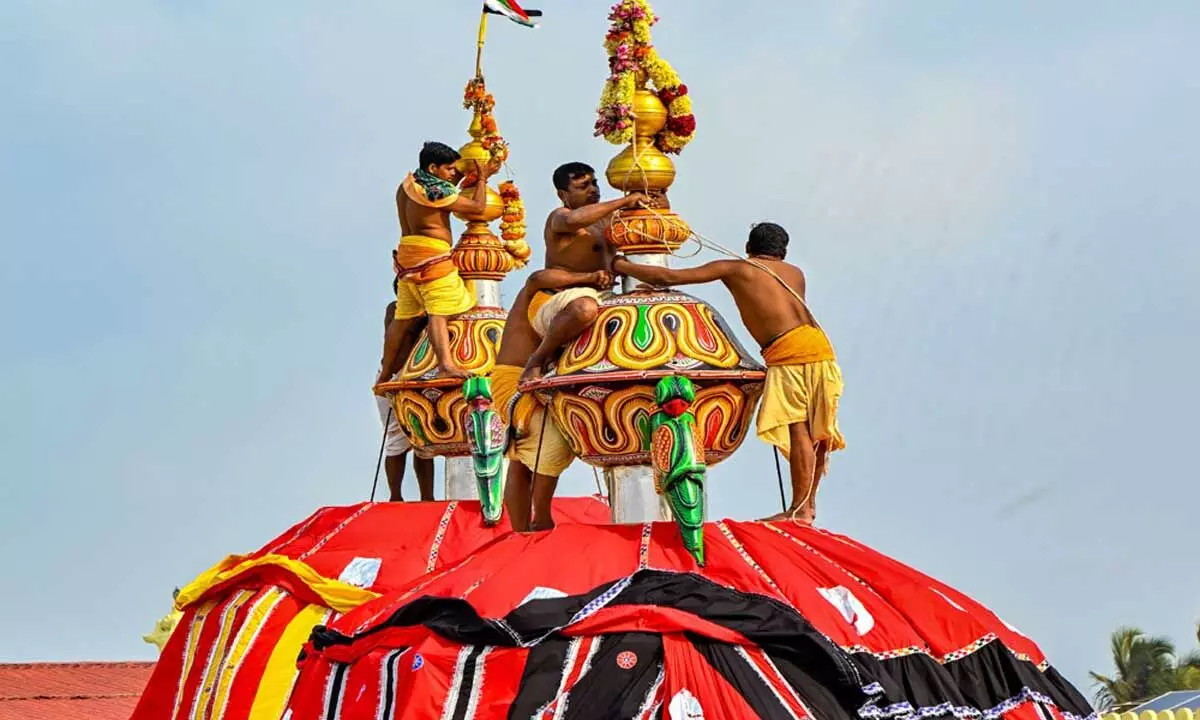Puri Rath Yatra: Chariot making ‘wonder in itself’- Hans Exclusive

Puri Rath Yatra is a ''wonder in itself'', the making of the chariots of three sibling deities for the world famous festival is one such wonder.
Puri: Puri Rath Yatra is a ''wonder in itself'', the making of the chariots of three sibling deities for the world famous festival is one such wonder.
Though three gigantic chariots are constructed every year afresh for the annual Rath Yatra, they are made by traditional carpenters with no formal training. Many of them have not even attended school. ''They have no manuals, architectural drawings or modern machines, but a group of craftsmen make gigantic and identical chariots for Lord Jagannath and his two siblings in Puri every year, using only traditional knowledge,'' says Sudarshan Mekap, the caretaker of the chariots.
Mekap said they do not use any modern instruments or take the help of any engineer. However, the fitness certificates for the chariots are given by government engineers after verifying that they are suitable to roll on the roads, he said.
Lord Jagannath's 'Nandighosha' chariot is 44 feet 2 inches, Lord Balabhadra's 'Taladhawaja' chariot is 43 feet 3 inches and Devi Subhadra's 'Darpadalana' chariot is 42 feet 3 inches. However, the makers of these chariots have no such measurements like feet and inch.
Bijay Mohapatra, the chief 'Biswakarma' (carpenter) of Lord Jagannath's 'Nandighosha' chariot having 16 wheels, said: ''I have been engaged in chariot making for about four decades. I was trained by my father Lingaraj Mohapatra and he received training from my grandfather Ananta Mohapatra.'' Only traditional equipment like chisels are used in the construction of the chariots, he said. 'It is a tradition and we are privileged to get the opportunity to serve the Lord,'' Mohapatra said, adding that now his teenage nephew Rudra Mohapatara, a college student, is under training. ''The senior carpenters make the younger ones learn the technique ofchariot making and remember the measurements made through hand,'' he said.
Rudra said he has been in the Ratha Khala (yard) for 57 days duringthe college summer vacation. He will join studies a day after the Rath Yatra this year. ''Though our children live outside Puri for a living, all of them come for two months and help their fathers in chariot making. It is considered to be a pious work for all of us,'' Mohapatra said.
''Our measurements are in the units of 'haat' (hand size) and 'anguli' (finger size). There are no such units like feet or inches,'' Mohapatra said.
Asked how the 'haat' size remains the same over centuries as the lengths of the hands of different persons are not similar, Mohapatra said: ''My father has given me a stick. This stick is considered as one 'haat'. It is equivalent to 20 inches. Twenty-five 'angulis' make a 'haat'. We use these measures to calibrate the height and width of the chariots.'' Not only carpenters but also a group of artisans and blacksmiths are involved in the chariot-making work for generations. While the 'Bishwakarma Sevaks' look after the main construction of chariots, 'Pahi Maharanas' fix the wheels of the chariots. There are others like 'Ojha Maharanas' (blacksmiths) who prepare nails, pins, clamps and iron rings.
This apart, various wooden sculptures such as 'Ashta Manjari' (eight women) are fitted on the chariots. Covers, canopies and flags made of cloth are prepared by tailors. ''As many as 220 traditional craftsmen are engaged in chariot making for 57 days,'' said Mekap.
A team of engineers from the State government's Works department and the Railways are kept ready for any repair work in the event of a breakdown of the chariots, Mekap said. After the completion of the festival, the chariots are dismantled and major portions of them are auctioned. The remaining wood is sent to the temple kitchen.















